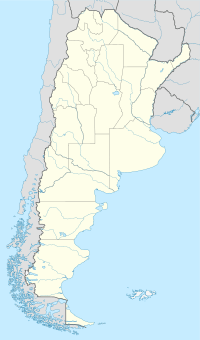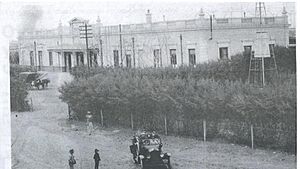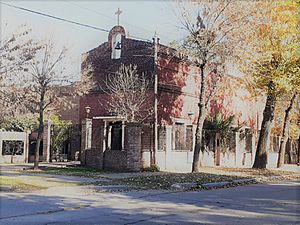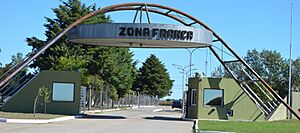Justo Daract, San Luis facts for kids
Quick facts for kids
Justo Daract
|
|
|---|---|
| Country | |
| Province | San Luis |
| Department | General Pedernera |
| Founded | March 10, 1907 |
| Founded by | Juan Martín Albizú |
| Elevation | 403 m (1,322 ft) |
| Population
(2010 census)
|
|
| • Total | 12,135 |
| Demonym(s) | Daractense |
| Time zone | UTC-3 (ART) |
| CPA Base |
D 5738
|
| Area code(s) | +54 2657 |
Justo Daract is a city in the San Luis Province of Argentina. It's the fifth largest city there. You can find it in the eastern part of a region called Cuyo. It's close to the border of Córdoba Province. The city is located along National Route 7, a big road that connects Buenos Aires to Mendoza and even Santiago, Chile. The city is named after Don Justo Daract, who was the first governor of San Luis Province.
Contents
History of Justo Daract
Early Inhabitants: Indigenous Peoples
The very first people to live in the area of Justo Daract were the Huarpes. They belonged to a group called the "Michilingües." When the first Spanish settlers arrived, they made friends with these local people.
One Spanish settler, Juan Gómez Isleño, married a Michilingüe princess named Arozena Koslay. She became "Juana Koslay" after a Catholic baptism. Other settlers also married indigenous women. These marriages created the first mixed-race families in San Luis Province.
In 1594, the government officially recognized Juana Koslay and Juan Gómez Isleño as the owners of the land where Justo Daract is today. However, over time, the indigenous people were forced out. The land then became public property.
First Landowners and New Names
After the indigenous people left, the government gave land to military leaders. These leaders were part of the Border Troops. In 1858, a law was passed giving them land.
One large piece of land, called lot "A," was sold to José Parellada. He was not a military leader but bought the land to invest. He named his property "La Esquina," which means "The Corner" in Spanish. This was the first name for the area of Justo Daract. In 1874, Parellada sold this land to Wenceslao Paunero.
Another large piece of land, lot "B," was given to Juana Larice. She inherited it from her husband, Apolinario Moreno, who was a military leader. Juana Larice also sold her land to Wenceslao Paunero. She sold it just 54 days after Parellada. However, she couldn't read or write well. Paunero paid her 800 pesos less than he paid Parellada.
The last piece of land, lot "C," was meant for Primitivo Capdevila. But he didn't register it in his name. Instead, he gave it to Wenceslao Paunero in 1878. This way, Paunero became the only owner of all three lots.
In 1904, Paunero changed the name "La Esquina" to "La Esperanza." This means "The Hope" in Spanish. This was the second name for Justo Daract. On August 14, 1904, a smart British merchant named Ludwig Bewig bought "La Esperanza" from Paunero. This new deal added 492 hectares to the land. Even though Bewig only owned the land for one year, he is also considered an early landowner. At this time, the land was empty, and there were no plans for a railway station. On June 12, 1905, a Basque merchant, Juan Martín Albisú, and his brothers bought the land from Bewig.
Founding of the City
March 10, 1907, is considered the founding date of Justo Daract. On this day, the Albisú brothers' land was sold in a public auction. The area became known as "Colony and Town Juan Martín Albisú."
Albisú understood how important the land would become. Two new railway lines were planned to connect to the main network of the Buenos Aires and Pacific Railway. This was a British company that later became the General San Martín Railway. These lines would link Bahía Blanca in Buenos Aires Province with La Paz in Mendoza Province.
In 1910, a railway station was built in the colony. It was called "Kilometer 650." This station connected lines from Paunero and Villa Valeria (in Córdoba Province) to Villa Mercedes (in San Luis Province). In 1910, the station was renamed "Justo Daract." Because the station became so important, with telegraph and telephone services, the colony also adopted its name. This honored the first governor of San Luis.
The Impact of the Railway
Because the railway lines met here, workshops from Villa Mercedes were moved to the new station in Justo Daract. New railway lines were built. Workers and merchants started moving to the town, seeing a bright future. Hotels, places to stay, restaurants, and new houses were built around the station.
Building the "Cañada Verde" bridge and the railway line to Villa Valeria created many jobs. This helped trade grow. There was a huge need for bricks to build railway buildings and houses. So, a brick kiln (a special oven for making bricks) was built by the Grosso company.
Also, in late 1907, a bridge was built over the Río Quinto. This bridge connected Justo Daract with the "La Paz" railway station in Mendoza. Around the same time, a new railway station building was constructed. Repair stations for locomotives and a construction station were also built.
All this building and the movement of goods created a big demand for workers and materials. This led to strong economic and population growth. The town quickly grew. From 1914 to 1920, it went from the eighth most populated town to the third most populated.
In its first 50 years, the busy railway activity helped the town get drinking water, a registry office, primary schools, a library, sports clubs, and many houses.
First Schools and Library
The first provincial primary school in Justo Daract was School No. 107. It opened in Villa Salles on July 21, 1910. In January 1914, the first public library was founded. It was named "Domingo Faustino Sarmiento."
The first secondary school, called Jesús Obrero Technical School, opened on March 15, 1949. Even today, it is the school where most students enroll.
The Chapel and Churches
The people of Justo Daract have always been very religious. Before a chapel was built, they used their own homes for religious services.
Construction of the Sagrado Corazón Chapel began on July 8, 1934.
Today, the main church in town is the Jesús Obrero y Nuestra Señora del Carmen Parish Church. It is in the center of town. Two other chapels are also overseen by this church: Nuestra Señora de Luján Chapel in Villa Salles, and Nuestra Señora del Rosario de San Nicolás Chapel in the "La Esperanza" neighborhood.
Free-Trade Zone
In 1994, a special law allowed free-trade zones to be created across Argentina. These zones offer big benefits for international trade. When a free-trade zone was approved for Justo Daract in 1996, people were very happy. The town's mayor even said it would be as important as the railroad was in its best days. Locals celebrated in the streets, full of hope for the project.
However, the free-trade zone did not bring as much economic growth as expected. It didn't become the main source of jobs or money for the people.
Today, the free-trade zone is a place for industry, business, and logistics. Goods can enter and get special treatment regarding taxes and customs. Products are stored in large warehouses. They are then sent to different parts of the country as companies need them.
In early 2021, about 20 businesses were using the zone. They imported goods from countries like Austria, China, India, and Spain.
The free-trade zone offers services like storing, dividing, and handling goods. It also provides cargo loading and unloading. There is land available for building factories and warehouses. Electricity, water, and natural gas are also tax-free within the zone.
Tango Festivals
From 2005 to 2017, Justo Daract hosted the "International Tango Festival." This event usually featured dancers, singers, and an orchestra. Traditional local dishes were also served.
In 2018, the town hosted the "Festival de Tango Puntano."
Economy of Justo Daract
In the 1990s, many railway jobs were lost due to privatization. Later, new industries brought economic benefits. But then the economy slowed down, and only a few of those businesses remain today.
Now, Justo Daract's economy mainly relies on farming. There are also small and medium-sized businesses, many of which are related to agriculture. The free-trade zone also plays a role in the town's economy.
Climate and Environment
Justo Daract has a Mediterranean climate. This means it has warm, dry summers and mild, wet winters. It is also a very windy place.
To the south, there is the Quinto River (Río Quinto). This river used to be a popular spot for tourists. However, it is now very polluted.
| Climate data for Justo Daract | |||||||||||||
|---|---|---|---|---|---|---|---|---|---|---|---|---|---|
| Month | Jan | Feb | Mar | Apr | May | Jun | Jul | Aug | Sep | Oct | Nov | Dec | Year |
| Mean daily maximum °F (°C) | 87.8 (31.0) |
86.0 (30.0) |
82.4 (28.0) |
75.2 (24.0) |
68.0 (20.0) |
62.6 (17.0) |
62.6 (17.0) |
68.0 (20.0) |
71.6 (22.0) |
77.0 (25.0) |
82.4 (28.0) |
86.0 (30.0) |
75.8 (24.3) |
| Mean daily minimum °F (°C) | 59.0 (15.0) |
57.2 (14.0) |
55.4 (13.0) |
46.4 (8.0) |
39.2 (4.0) |
33.8 (1.0) |
32.0 (0.0) |
35.6 (2.0) |
39.2 (4.0) |
48.2 (9.0) |
53.6 (12.0) |
57.2 (14.0) |
46.4 (8.0) |
| Average precipitation inches (mm) | 4.25 (107.9) |
3.37 (85.7) |
3.72 (94.6) |
2.17 (55.0) |
1.12 (28.4) |
0.36 (9.2) |
0.73 (18.5) |
0.67 (17.1) |
1.39 (35.2) |
2.31 (58.8) |
3.38 (85.9) |
4.45 (113.1) |
27.92 (709.4) |
| Source: Servicio Meteorológico Nacional. Data from the reference period 1981-2010 | |||||||||||||
Population Growth
The last official count of people was in 2010. It showed that Justo Daract had 10,135 residents. This makes it the fifth most populated city in the San Luis Province.
| Vertical bar chart demographic of Justo Daract between 1947 and 2010 |
|
EasyTimeline 1.90
|
| Source: INDEC National Census |
See also
 In Spanish: Justo Daract (localidad) para niños
In Spanish: Justo Daract (localidad) para niños






